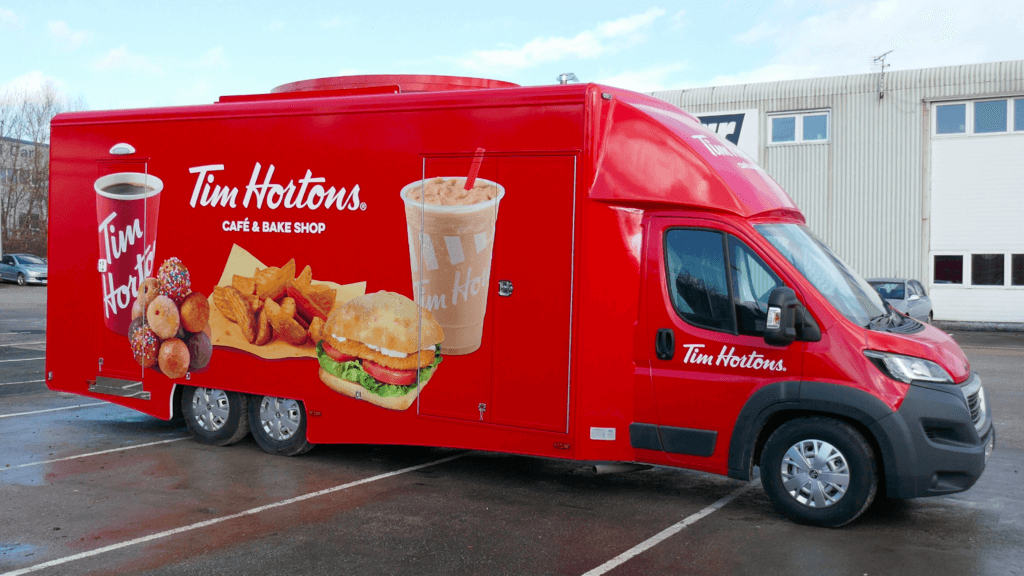By Rose Sugatan and Sam Marasigan
Truck advertising is a powerful tool that companies use to promote their products and services. It is a way to reach a large audience and communicate with them in a way that is memorable and effective. This type of advertising can influence people’s thoughts, emotions, and behaviours in a variety of ways, and the psychology behind it is fascinating.
It is important to note that psychology helps advertisers understand the reasons behind consumer decision-making. By applying knowledge of human perception and behavior, marketers can design mobile billboard ads that captivate and create unique experiences. Being well-versed about the psychological triggers that drive consumer behavior can help you to tailor your truck advertising campaigns to the needs and desires of your customers.

Image Source: timhortons.co.uk
Delving into such studies also allows truck advertisers to leverage emotional appeals to establish more genuine connections. Emotions heavily influence consumer decision-making, and ads that evoke positive emotions such as joy or nostalgia can leave a lasting impression. Mobile billboards, with their striking visuals and limited viewing time, provide an opportunity to create emotional impact in a brief moment, influencing consumer attitudes and preferences.
In this blog post, we will explore the psychology of truck advertising and examine the ways in which it can impact people’s behaviour. We will draw on insights from psychology, marketing, and neuroscience to gain a deeper understanding of how truck advertising works.
Mobile Billboards Attract the Eye
Mobile billboards possess a unique advantage over their static counterparts due to their ability to move and attract attention. They are also designed to captivate the eye and stand out in the environment. Research suggests that human attention is naturally drawn to movement, as it triggers our primal instinct to survive in our environment. When a mobile billboard passes by, the movement inherently captures people’s attention, increasing the likelihood of noticing and processing the ad.
Based on research conducted by the Visual Teaching Alliance, it is evident that approximately 65% of individuals are visual learners. This highlights the importance of visual elements in truck advertising, which can practically be anything from food to apparel and technology. As long as the mobile billboard is properly art directed with the right amount of visuals, it has the potential to capture attention, convey the brand’s message effectively, and leave a lasting impression on the audience.
Coupled with memorable visuals and movement, truck advertising is a dynamic and immersive experience for viewers. It not only captures their attention but also embeds the advertisement in their memory. The continuous movement of the truck ensures repeated exposures, reinforcing the brand message and increasing the chances of recall when the viewers are making purchasing decisions.
The Effect of the First Impression
In the world of advertising, first impressions play a crucial role in capturing attention, creating engagement, and leaving a lasting impact on viewers. Truck advertising is no exception. As mobile billboards traverse the streets, they have a limited window of opportunity to make a positive and memorable impression. Understanding the psychological dynamics behind first impressions can help advertisers harness their potential and optimize the effectiveness of truck advertising campaigns.
Psychologists have long studied the primacy effect, which suggests that individuals tend to remember and form lasting opinions based on initial information. When it comes to truck advertising, the first encounter with a mobile billboard is often the most critical. The visual and textual elements displayed on the truck must be carefully crafted to make an immediate impact, capturing attention and piquing curiosity within seconds. By focusing on creating a strong initial impression, advertisers can maximize the likelihood of their message being remembered and acted upon.
Truck advertising can tap into cognitive biases and emotional resonance to shape first impressions. Cognitive biases, such as the halo effect or confirmation bias, influence how people interpret and remember information. By presenting truckside ads in visually appealing settings or associating them with positive emotions, advertisers can leverage these biases to create a favorable first impression. For example, a truck advertisement showcasing plants and flowers or featuring happy, smiling people can elicit positive associations and make the brand more appealing to viewers.

Image Source: centredejardinfloreal.com
By recognizing the significance of first impressions and incorporating psychological principles into their strategies, truck advertisers can optimize the impact of their campaigns. A compelling and positive initial impression sets the stage for a deeper connection with the audience and increases the likelihood of continued engagement, ultimately driving the success of truck advertising endeavors.
Community Engagement and Brand Extension
One interesting aspect of mobile billboards is their potential to create a sense of community engagement and brand extension. When people see trucks or vehicles adorned with brand logos and messages, they may assume that these vehicles are actively involved in delivering products or services for that particular company. This assumption can enhance brand loyalty and generate positive associations between the brand and its community.
The phenomenon of associating a brand with its delivery vehicles is not new. Research suggests that when people see delivery trucks associated with a specific brand, it creates a perception of reliability, efficiency, and dedication to customer service. This perception stems from the idea that the company is actively working to meet customers’ needs by physically delivering their products or services.
Moreover, mobile billboards that also serve as delivery vehicles contribute to a sense of brand legitimacy and authenticity. People perceive the brand as an active participant in the community, providing products or services directly to their doorsteps. This involvement strengthens the emotional connection between the brand and its customers, creating a sense of loyalty and reinforcing positive word-of-mouth referrals.
Community engagement through mobile billboards also opens opportunities for interaction and relationship building. For instance, companies may design their mobile billboards in a way that encourages people to engage with the brand, such as in an advertising campaign called “Truck” from 2009, which was a stunt that involved placing a giant Mentos truck on the streets of three Canadian cities: Vancouver, Toronto and Montreal. The truck had a hole in its side and a trail of Mentos candies behind it, suggesting that the truck was filled with Mentos and some of them had spilled out. The campaign aimed to show that Mentos are “made from awesome” and to create buzz among pedestrians. The campaign was created by Cossette, a creative marketing and communications agency based in Canada.

Image Source: adsoftheworld.com
Mobile billboards, particularly when they are delivery vehicles, have the potential to create a powerful sense of community engagement and brand extension. The association between a brand and its delivery trucks can enhance brand loyalty, build trust, and strengthen the emotional connection between the brand and its customers. Leveraging this psychological phenomenon through mobile billboard advertising can effectively extend a brand’s presence and foster a positive brand image within the community.
The Power of Language
As we recognize the significance of visuals in truck advertising, it is equally essential to explore the influential role of words in conveying compelling messages and forging connections with the audience. Language plays a crucial role in truck advertising, as it serves as a powerful tool to convey messages, elicit emotions, and influence consumer behaviour. The words used in truck advertising campaigns are carefully crafted to create a specific impact on the target audience. One way in which language is leveraged to enhance the effectiveness of truck advertising is by having a compelling message that resonates with the target audience. It may include catchy slogans, memorable taglines, or succinct descriptions that leave a lasting impression.
Consider the remarkable collaboration between Movia and Koch Industries, where a captivating mobile OOH campaign was orchestrated in Washington, DC, and Atlanta, Georgia. Demonstrating their astute understanding of human psychology, Movia strategically conveyed a message of sustainability while ensuring the campaign had a net-zero emission impact. Leveraging their partnership with third-party delivery trucks and pre-established routes, Movia executed this ingenious plan by boldly proclaiming for Koch: “We recycle a box this big every second.” This perfectly complemented the truck’s size and box-like shape, which effortlessly captured attention and triggered subconscious associations. Not only did Koch Industries exemplify their commitment to sustainability, but Movia also contributed to a broader green initiative. For every truck deployed, Movia planted a tree as part of their tree planting carbon offsets. This extraordinary partnership resulted in the planting of 6,000 trees, further fueling the psychological impact of the campaign.

Image Source: movia.media
Another way language is used to tap into the emotions of viewers and evoke desired responses is via emotional appeal. Carefully chosen words on truck advertisements can evoke excitement, adventure, reliability, or aspiration, creating strong emotional connections with the brand and its offerings. By employing language that aligns with the target audience’s desires and aspirations, truck advertisers can effectively engage consumers on an emotional level.
Moreover, truck advertising utilizes clear and compelling calls-to-action to motivate viewers to take specific actions. Well-crafted language prompts consumers to visit a website, make a purchase, or contact the brand, guiding them along the buyer’s journey. The power of language in truck advertising cannot be understated. The choice of words, tone, and overall messaging all contribute to shaping the success of advertising campaigns. By understanding the psychological impact of language and employing it strategically, truck advertisers can effectively communicate messages, establish emotional connections, and drive desired consumer behaviors.
The Power of Social Influence
Truck advertising can also use social influence to impact people’s thoughts and behaviours. This is because humans are social creatures, and we are influenced by the opinions and actions of others. Mobile billboards possess the potential to influence social perceptions. Source credibility is an important factor influencing assumptions. Research suggests that people tend to rely on peripheral cues, such as the expertise or trustworthiness of the source, to make judgments. Mobile billboards that display endorsements from reputable individuals or organizations can positively influence people’s assumptions about the business being advertised.
For example, a truck advertisement might feature a celebrity or influencer who endorses the product. This can create a sense of social proof among viewers, making them more likely to view the product as desirable and worth purchasing. When viewers see real people—especially the ones they like and agree with—endorsing a product or service on a mobile billboard, it creates a sense of trust and credibility.
Image Source: bloomberg.com
The presence of a well-loved personality communicates that others have tried and approved your product or service, and audiences are more inclined to view it as a viable option. This psychological mechanism taps into our innate desire for social validation and the belief that if others find something valuable, it is likely to be valuable for us as well.
The Power of Neuroscience
Finally, the psychology of truck advertising can be further explored through the lens of neuroscience. Neuroscience studies the relationship between the brain and behaviour, and can provide insights into how truck advertising impacts the brain.
One study found that when people view images of powerful vehicles, such as trucks, their brains show increased activity in regions associated with reward and motivation. This suggests that truck advertising can tap into people’s reward systems, creating a sense of pleasure and motivation that encourages them to take action, such as considering purchasing the product.

Image Source: oohtoday.com
Another study found that when people view images of vehicles, their brains show increased activity in regions associated with identity and social cognition. This suggests that truck advertising can tap into people’s sense of identity and social recognition, creating a sense of connection and belonging that encourages them to view the product as desirable and worth purchasing.
Conclusion
The psychology of truck advertising is a complex and fascinating topic that can influence people’s thoughts, emotions, and behaviours in a variety of ways–using visuals, language, social influence, and neuroscience. Not having a solid understanding of psychology as an advertiser can have significant drawbacks. Without this knowledge, you may struggle to effectively communicate your message to your target audience. The result could be truck ads that fail to capture attention, and your advertising efforts may not resonate with your intended audience, leading to lower engagement, reduced conversions, and a waste of resources.
By understanding the psychology of truck advertising, companies can create more effective and impactful campaigns that resonate with their target audience. And by being aware of the psychology behind truck advertising, consumers can make more informed decisions and avoid being unduly influenced by marketing tactics. Ultimately, the psychology of truck advertising reminds us of the power of persuasion and the importance of critical thinking. By understanding the techniques used in truck advertising, we can be more mindful of how we make decisions and more aware of the forces that influence our behaviour.


